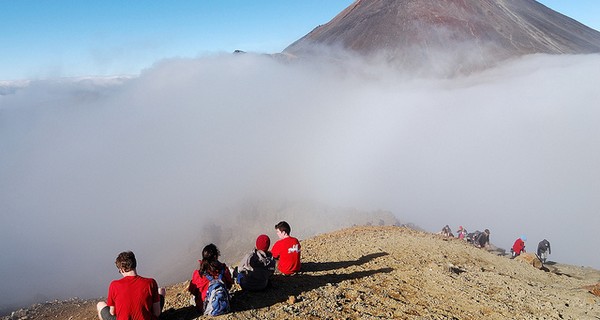Adventure tourism has become popular day by day. And of these the most typical form is hiking. So there’s always a lookout for top hiking trails that you can go on. For people like us who spend a lot of time out in nature; It seems like every stretch of wilderness we explore makes us hungrier to conquer another. But those who really do enjoy this peaceful outdoor activity have plenty of incredible choices in every corner of the world. Here are the ten best hikes on the planet. Each with a combination of scenery and special extras that make them well worth going out of your way to enjoy.
Hikers often have their wish lists of the most amazing treks on the planet. Have a look at the 10 best hikes from around the world and get ready to book your trail pass.
10 Best Hiking Trails Around The World:
1. Kungsleden, Sweden

Kungsleden is a hiking trail in northern Sweden, approximately 440-kilometre long, between Abisko in the north and Hemavan in the south. It passes through one of Europe’s largest remaining wilderness areas.
Abisko Mountain Station to the Saami Village of Nikkaluokta.
Round-Trip: 65 miles, 3 to 5 days
When to Go; Many travelers in Europe may head to the beachy scenes of the Mediterranean in the summer. Some like to escape the heat by going north to Scandinavia.
A hundred miles inside the Arctic Circle, Sweden’s legendary 275-mile Kungsleden (the “The King’s Trail”) begins its traverse of the last great wilderness in western Europe. This mind-blowing northernmost section penetrates the vast Arctic landscape of Sweden through birch forests, open tundra, and big glaciers before crossing the shoulder of Sweden’s highest peak, 6,926-foot Mount Kebnekaise. Using the comfortable huts placed about a day apart assures you have refuge in bad weather. Sturdy suspension bridges take the danger out of the big rivers. The vibe here is “far north,” with palpable emptiness and low-angled light that stirs the soul. The route can be done in either direction, but do it north to south, as that keeps the sun on your face—no small consideration in the Arctic.
2. Grindenwald, Switzerland

Switzerland is also known for its chocolates, its army knives, and its holey cheese. Above all, it very famous for its neutrality; this central European country is a place of peace, not only politically, but for your own sanity. Grindelwald is a municipality in the Interlaken-Oberhasli administrative district in the canton of Bern in Switzerland. The village is located at 1,034 m (3,392 ft) above sea level in the Bernese Alps.
Round-Trip: 10 miles if you ride up and walk down, 2 to 3 days
When to Go: High summer is the season here, but hikable weather often extends into September, when the Europeans are back at work. The Faulhorn closes in October.
Perhaps the biggest payoff for effort applied in the Alps, this ridiculously beautiful walk takes in the scenic highlights of the Bernese Oberland—including the notorious Eiger and its more impressive sister peak, the fearsome Shreckhorn—looming across Grindelwald’s fairy tale valley.
All this, and a night or two at the comfortable Faulhorn hut or berghotel, impossibly perched at 8,800 feet on its namesake peak, for just a day’s worth of hiking. Even if you ride the lift on the way up, be sure to walk down, and have lunch at Waldspitz, a classic Swiss mountain chalet where you’ll enjoy a tasty rösti watching snow plumes blow off the summit of the Shreckhorn so close it’s scary.
3. Grand Canyon Hike, Arizona

The Grand Canyon is a steep-sided canyon carved by the Colorado River in the United States in the state of Arizona. It is contained within and managed by Grand Canyon National Park, the Hualapai Tribal Nation, and the Havasupai Tribe. It is a huge fissure in the Colorado Plateau that exposes uplifted Proterozoic and Paleozoic strata, and is also one of the 19 distinct physiographic sections of the Colorado Plateau province.
Round-Trip: 44 miles, 4 to 6 days
When to Go: Everybody does this hike in September to October or April to May, so go in March or November for a more contemplative experience.
Any walk in the Grand Canyon is going to rate pretty high on the Richter scale of hikes, but this route shows you both rims and the river, offers different trails in and out, and gives you enough time within one of the greatest features on Earth to actually savor the majesty of the natural architecture. Time travel through the multicolored layer cake of the Colorado Plateau for two billion years’ worth of geology, from the Kaibab limestone at the rim to the Vishnu complex at the river, all on good “corridor” trails with known water sources and pleasant camps.
Insider Tip: Bomb down from the South Rim via the uber-direct South Kaibab Trail to cross the Colorado River on the Black Bridge and camp at Bright Angel camp. Then ascend through the Box, the inner heart of the canyon, up to Cottonwood Camp and the remote North Rim. On the return trek, cross the Colorado on the Silver Bridge and ascend to the South Rim through Indian Garden via the Bright Angel Trail, better suited for uphill travel.
4. Routeburn Track, New Zealand

It is certainly no secret that New Zealand boasts some of the world’s most beautiful and dramatic scenery, which is why it’s not surprising that one of the world’s most spectacular hikes is located on these mountainous islands.
Round-Trip: 32 km, 3 to 4 days
The Routeburn Track is a world-renowned tramping (hiking) 32km track found in the South Island of New Zealand. The track is usually completed by starting on the Queenstown side of the Southern Alps, at the northern end of Lake Wakatipu, and finishing on the Te Anau side, at the Divide, several kilometres from the Homer Tunnel to Milford Sound.
The New Zealand Department of Conservation classifies this track as a Great Walk and maintains four huts along the track: Routeburn Flats Hut, Routeburn Falls Hut, Mackenzie Hut, and Howden Hut; in addition there is an emergency shelter at Harris Saddle. The track overlaps two National Parks; the Mount Aspiring National Park and Fiordland National Parks with the border being Harris Saddle.
5. Everest Base Camp Trek, Nepal

Lukla to Everest Base Camp.
Everest Base Camp Trek is a famous challenging trek in Khumbu, Nepal. Famous for its spectacular mountain peaks and the loyalty and friendliness of its inhabitants (the Sherpas), the Everest region (Khumbu) is one of the most popular destinations for tourists in Nepal.
Round-Trip: 70 miles, 16 days
When to Go: Pre-monsoon (March or April) gives you the rhododendrons in bloom and lots of climber action, but post-monsoon (November) gives you drier weather. Go with guide services that use local Sherpa guides, cooks, and porters—it’s part of the experience.
Arguably the greatest of all high-mountain journeys, this stroll through Nepal’s Khumbu district lets you see three of the highest peaks on Earth (Everest, Lhotse, and Lhotse Sar) in one glance—and dozens more Himalayan giants along the way. A favorite is the view from Thyangboche, called by renowned mountain explorer W.H. Tillman the “greatest view in the world.” But it’s the deep immersion in the Sherpas’ Buddhist culture that will bring you back for the friendly villages, the monasteries, and the polyglot scene of world travelers who come for the high-octane pilgrimage to Everest.
Insider Tip: Go slow on the way up. Healthy hikers could cover 35 miles in two days, but the need to acclimatize means you’ll take ten days on the trek in to Everest, but only three on the trek out. The enforced downtime allows you to savor the experience—and the culture of people who live there.
6. Zion Narrows, Utah, United States

The Narrows in Zion National Park, is a section of canyon on the North Fork of the Virgin River. The hike of The Narrows is one of the premier hikes on the Colorado Plateau.
While hiking through the volcanic landscape of the Tongariro northern circuit may provide enthusiasts with an extraterrestrial experience, hikers are sure to be amazed at the unique and stunning scenery of trekking through the Zion narrows in the American southwest. Recently ranked as #5 on National Geographic’s list of America’s Best 100 Adventures, this trail will have you hiking up streams through dramatic, narrow slot canyons.
Hikers will wind their way through colorful, sculpted sandstone walls that rise up to 3,500 feet (that’s just about 1 km). The trek will also lead hikers through the famous “Wall Street,” a 2-mile section of the journey that crosses through a narrow canyon where the walls close to just 22 feet wide at the top. Hiking through water for about 60% of the hike up the streams that wind their way through these breathtaking slot canyons, you will see hanging gardens bursting from the red canyon walls, trickling water threading through cracks in the canyon walls and sprouting patches of moss, waterfalls sliding over the sandstone, and sandy banks with towering ponderosas.
However, while this wondrous journey is sure to enchant hikers, it should be noted that hiking through the Zion Narrows is extremely dangerous, as flash floods can come quickly and the entire area is a huge drainage. Rainstorms up to 50 miles away can storm down the canyon and every year hikers die on this trail. Make sure to check the weather report in advance to make sure there is NO RAIN whatsoever in the forecast. However, with proper precautions, this hike, which is rated as one of the best hikes in the entire U.S. National Park system, is truly unparalleled.
7. Fitz Roy Trek, Patagonia, Argentina

One of the best hikes in the world is Around Monte Fitz Roy. Fitz Roy is at the northern tip of gorgeous Parque Nacional Los Glaciers, itself part of Hielo Sur, the largest icecap not in a polar region.
Round-Trip: 36 miles, 4 to 7 days
When to Go: February to March to avoid the crowds of midsummer and enjoy stable fall weather when the infamous Patagonian winds abate
Hike among Argentina’s fabled Fitz Roy Massif, the iconic ridge where the peaks of Poincenot, St. Exupery, and 11,073-foot Fitz Roy itself rise out of the steppes of Patagonia like a vision. This grand tour gives you three views of Fitz at sunrise, with Cerro Torre and Marconi Pass thrown in for good measure. This ramble through Delaware-size Los Glaciares National Park takes you from gnarled, spooky beech forests and open plains to glaciers, roaring waterfalls, and granite monoliths afire with orange dawn light.
Insider Tip: From Camp Poincenot, hike up in the predawn hours to Laguna de los Tres by headlamp for the full impact of sunrise on the Fitz Roy Massif.
8. Petra Through the Back Door, Jordan

Round-Trip: 50 miles, 7 days
When to Go: October through April, when desert temperatures relent—a little. Go with Adventure Jordan, the local company that discovered this 50-mile route through the deserts, mountains, and peaks of Jordan.
Beyond Yosemite, The Grand Canyon, and the Appalachian Trail lie continents brimming with landscapes both transcendentally gorgeous and foreign. This 50 mile trek, which darts through the desert and mountain peaks of Jordan, is one such landscape, and the seven day journey’s buffet of breathtaking views easily justifies a trip beyond our borders.
The trail was found by the company Adventure Jordan. And they’ll be the ones leading you through the ancient stairway and beyond. Of course, the final destination will be the Nabataean City of Petra, one of the East’s most precious treasures and a UNESCO world heritage site, but it is the journey to The Rose City that makes the trip worthwhile. The unapologetic ruggedness of the Sharah mountains, the otherworldliness of Bedouin camps dotting the wild landscape—this trip is unlike any you have done before and any you will ever do again.
9. Tonquin Valley, Canadian Rockies, Alberta, Canada

The Tonquin Valley is located in Jasper National Park, Alberta, Canada, next to the border of the provinces of Alberta and British Columbia, an area which is also the continental divide, running along the peaks of the South Jasper Range which rise above Amethyst Lake.
Round-Trip: 27 miles, 3 to 5 days
When to Go: July to September; it can snow any day of the year.
Watching the sunrise light up the enormous broadside of the Ramparts, throwing golden reflections into the waters of Amethyst Lake, is an experience worthy of any effort expended to get into this wild valley. First photographed in 1915, the unrelenting beauty of the Tonquin Valley, nestled deep in the heart of the Canadian Rockies, has drawn pilgrims ever since—including Ansel Adams, whose very first trip as a Sierra Club photographer was right here. This big hiking loop takes you in over high, scenic McCarib Pass and out via the lovely Astoria River, laying the whole mind-blowing landscape before you in a backcountry journey to rival any.
Insider Tip: If all those grizzly bears wandering around make you uneasy; Consider booking accommodations at two wilderness lodges hidden at the edges of the valley. Founded as horsepacking operations, both the Amethyst Lake Lodge and Tonquin Valley Lodge increasingly cater to hikers looking for a bit of comfort and home-cooked meals in this wild place.
10. Mountains of the Moon, Uganda

The Rwenzori Mountains (Mountains of the Moon), is a mountain range of central Africa, often referred to as Mt. Rwenzori, located on the border between Uganda and the Democratic Republic of the Congo, with heights of up to 5,109 m (16,761 ft). The highest Rwenzoris are permanently snow-capped. And they, along with Kilimanjaro and Mount Kenya are the only such in Equatorial Africa.
Round-Trip: 38 miles, 6 to 7 days
When to Go: December to March, the “dry” season. Go with guides and porters; they know the way and are not expensive.
When approaching high-altitude glaciers, you don’t often hear locals say; “There are elephants here.” But everything about the Ruwenzori Range, Ptolemy’s legendary Mountains of the Moon, is unexpected. Looming on the Uganda-Congo border, these peaks make up the highest range in Africa, rising to 16,765 feet at the Margherita summit of Mount Stanley. (Kilimanjaro and Kenya are taller, but they aren’t ranges.)
You’ll hike three days through two 14,000-foot passes; And mind-bending forests of giant groundsel and giant lobelias to get to the Bujuku Hut, base camp for those wanting to climb Mount Speke. Hike also one more day to Elena Hut, base camp for those who want to climb the glaciers. And try for the summit of Mount Stanley for its unique views of the Congo Basin. Two more trail days take you over Scott Elliot Pass, the highest on the circuit at 14,344 feet, and back to the starting point for your eventual return to Kampala.
Insider Tip: Bring a pair of indestructible camp shoes impervious to moisture, such as Crocs. The circuit can be a muddy mess. Walking in the creek beds often makes for the best progress. It is essential to be able to change into something dry and reasonably comfortable for your feet at day’s end.
FAQs: Best Hiking Trails From Around The World
What is the most popular hiking trail in the world?
What is the most beautiful thru hike in the world?
What are the best places to hike in the world?
The Swiss Alps: Known for their stunning mountain landscapes and well-maintained trails.
Patagonia (Chile and Argentina): Offers rugged and remote wilderness with diverse ecosystems.
Banff National Park (Canada): Famous for its pristine lakes, glaciers, and mountain vistas.
The Dolomites (Italy): Renowned for dramatic limestone peaks and picturesque valleys.
Torres del Paine National Park (Chile): Features dramatic granite spires and pristine wilderness.
Where is the most beautiful place to hike?
The Cinque Terre in Italy: Famous for its coastal trails and colorful villages.
Zion National Park in the USA: Known for its red rock canyons and breathtaking vistas.
Iceland’s Highlands: Offers surreal volcanic landscapes, geothermal areas, and waterfalls.
The Amalfi Coast in Italy: Features picturesque coastal trails with stunning sea views.
The fjords of Norway: Offers dramatic scenery with deep, narrow inlets surrounded by towering cliffs.






